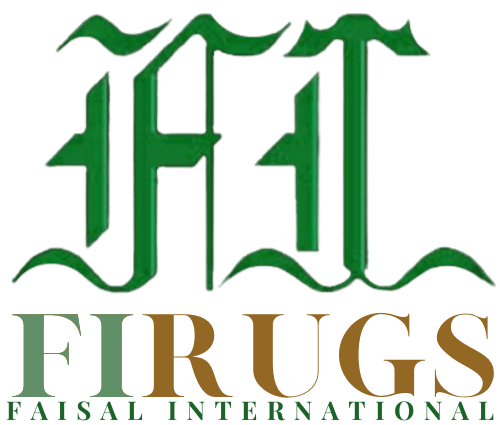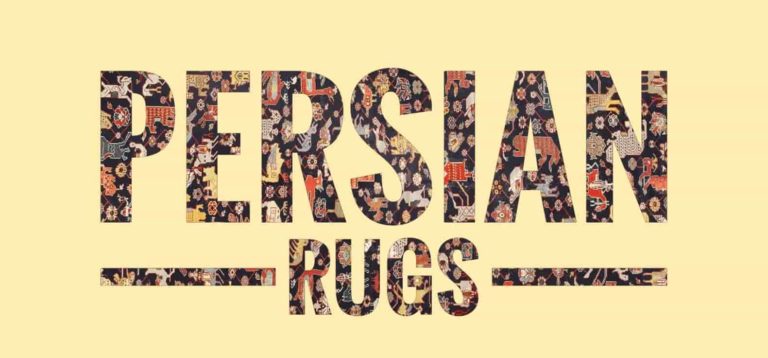
Table of Contents
What Are Persian Rugs
What are Persian rugs? Persian rugs are hand-woven rugs in wool or silk or both. They usually have floral design patterns made with several knots and have natural fringes at both ends.
A traditional Persian rug has a thick and dense pile, usually about 160 knots per square inch. They are traditionally recognized for their wide variety of unique designs, fabrics and vibrant colors.
History Of Persian Oriental Carpets
The history of the manufacture of handmade carpets began in the fourth century. These are also called Pazyrk rugs, first found in Siberia in 1949. According to many carpet experts, the Pazyrk carpet was woven in the Caucasus. History shows that carpet manufacturing has been woven and marketed since ancient times.
Throughout the Middle East, carpets are not only as objects of everyday life but as a way of saving. The families then treasured these carpets so much that they were safely stored in different bank vaults. When necessary, these valuable carpets were sold for money.
Types Of Persian Rugs
Identifying types of oriental rugs may not be easy for everyone. Persian carpets and rugs are named after the city names they originated from with slight differences. They are also named based on the design, weaving technique, and type of fiber. There are different styles of oriental rugs. Some of the names of rugs are:
Tebriz, Kashan, Kazak, Nain, Mashad, Gabbeh, Herat, Ishfan, Bakhtiari. Some of the others are Ahar, Abadeh, Kazan, Kashmar, Ferdos, Ishak, Heriz, Isfahan, Beluch, Shiraz, Qom, Veramin, Zabol, and others.

Turkish Vs Persian Rugs
What are Persian rugs and Turk rugs?
Well, the main difference between Persian and Turkish rugs is their different design patterns. Oriental Persian rugs look royal and have a medallion design in the center. They have clean, elegant rounds, motifs, and designs. Turkish area rugs have different design patterns.
Unique Persian Rug Symbols
Persian design rugs usually have designs and symbols taken from nature. Flowers, eyes, birds, amulets, water waves and many other such designs make them look unique.
Persian rugs have been creatively made by artisans for centuries. They continue to be a popular choice in floor fashion today. The impeccable quality of Persian rugs offers both a functional and focal point for any room. With such popularity and quality, it is easy to see why there are so many imitations they have. Don’t get fooled, make sure an accredited distributor evaluates yours if it’s the right price you’re paying for. Contact and cross check with your nearest Persian rug dealers before buying.
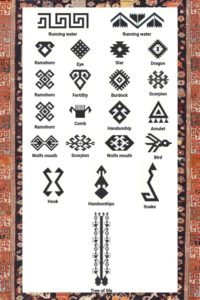
Difference Between Persian And Oriental Rugs
Wait! What are Persian rugs and oriental rugs?
Persian hand-knotted rugs originated in Persia (now known as Iran). So Iran rugs are actually considered the original form of Persian rugs. Wool, the natural resource has been available in plenty. The art of weaving, the softness of wool and its durability encouraged Iran to market them worldwide.
They are also well known as Oriental rugs manufactured in Asian countries. The Mughal empire invaded and spread this fine art from Iran to subcontinents of Asia. India, Nepal, China, Tibet, Pakistan, Turkey, and Afghanistan produce these handmade rugs as well.
What Material Persian Rugs Are Made Of
The most common material used in the manufacture of Persian rugs is natural sheep wool. New Zealand wool is one of the best quality wool for carpet manufacturing. They are also the most expensive wool. Followed by New Zealand wool is Semi-worsted wool and Indian wool (Bikaner wool). These wool are of good quality and considered for the production of the best handmade oriental carpets. The other types of wool to make these rugs are Kork wool, Manchester wool, and Camel wool.
The combination of silk and wool rugs is another form of them, luxurious and expensive. Wool and silk together also creates a unique art but expensive too. Yes, it is the silk produced by the silk-worms or the caterpillars. These days wool is combined with bamboo-silk to create the same look like that of real silk but affordable.
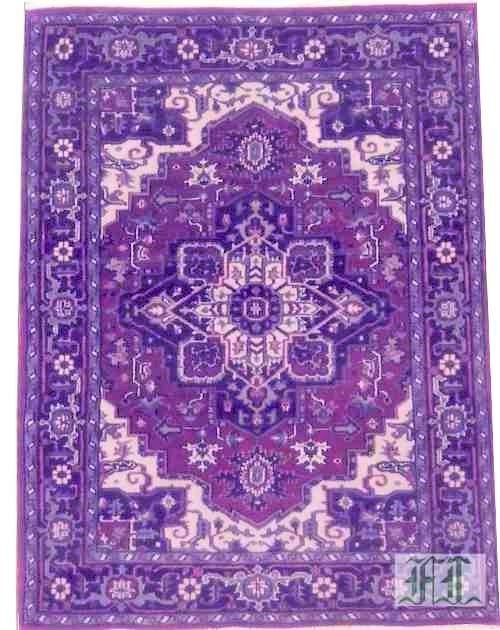

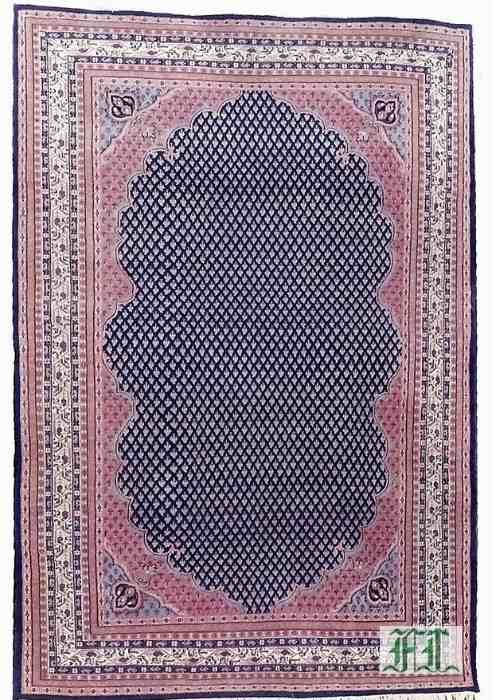
How Do They Make Persian Rugs?
- Well, the best quality sheep and lamb wool are first cut, washed and bleached. The fibers are then straightened and spun. A master dyer then proceeds with color dying the spun wool.
- The vegetable dyes extracted from roots, flowers, and fruits make all natural colors.
- After the dyeing process, the wool is hung under the sun to dry.
- Warp threads of thread that extend along the entire carpet, in which the weaver ties the knots.
- Weft threads of yarn that run across the carpet between the warp threads to keep the knots in place.
- The fabric usually starts from the tail of the loom. Several numbers of thread pass through the warps to start a root. Then, different types of rug materials such as wool, cotton threads are hand-tied in rows around continuous sets of contiguous wraps. As more and more rows are hand-knotted one after another, they become the pile of the carpet.
- Once the carpet is fully woven, they are then cut from the loom and sent for a wash. After washing, the fiber goes through the trimming process.
- The bindings on both sides of the carpet take an hour to complete using the same dyed wool. The carpet goes through many finishing processes and is then rolled and packed.
Time Taken To Weave A Persian Rug
It takes a lot of time and effort to make Indian oriental rugs. The higher the quality of the carpet (number of knots per square inch), the longer it will take to weave them. It would take approximately 15 months to complete a 9’x12′ (2750 x 3650) oriental rug. This is with 500 knots per square inch and with 3-4 craftsmen weaving at least 6 hours a day.
How To Count Knots
An authentic Persian carpet is hand-knotted and knotted rugs carry knot counts. One can tell the quality of such rugs by counting the number of knots they have. Higher the knots means better the quality of a rug. So how do you read the Persian rug knots? Well, it’s all at the back of the rug.
To read, count the number of knots of the wrap(length) per linear inch and the number of knots of the weft(width) per linear inch. Multiply both to get number of knots/sqr.in
Calculation Of Oriental Rugs Knots In India
In Varanasi – A carpet manufacturing hub in India, Oriental handmade carpets are classified using 2 numbers. For example, 5/40, 9/45, 12/60 and many others as such.
Here the first number that’s called ‘Bis’, denotes the horizontal(width) knots. These are rug’s width knots in 0.9 of an inch. Calculate to find knots per horizontal inch by taking 11% of the bis and sum it up to the bis.
The second number known as ‘Butaan’ denotes the number of vertical(length) knots in 4.5 inches of a rug.
To get a number of knots per vertical inch, simply multiply Butaan by 0.333 and sum it to the Butaan readings you got.
Finally, the simple formula is:
0.9 inches x 4.5 inches = 4.05 inches. (approx. 4 inches)
Now let’s pick a rug quality 9/60 and calculate for an example purpose.
9×60 = 540,
540/4 = 135,
Hence, the number of knots per square inch in a 9/60 rug quality is 135.

The Durability
One question that every customer asks is how long do Persian carpets last. Well, it is not easy to give a defined period. The main charm of real Persian rugs is that they are elegant and strong. Yet, they are also very durable. The durability of these carpets depends a lot on the quality(KPSI) of the carpet. It also depends on the type of fiber used. In other words, if the density of the carpet pile is high, the carpet lasts longer. The amount of foot traffic received also plays an important role in its durability.
A Persian carpet of good quality if taken care of can last more than 100 years during use.
What Are Persian Rugs Benefits
Oriental carpets have long been treasured as an art form. It is the uniqueness of oriental carpets that decorate a room more beautiful than any other. The real beauty of them is the wide range of colors and designs they have.
Indian oriental carpets are versatile, they are not only used as distinctive floor coverings, but you will also often see an oriental carpet used as a tapestry. They have a great visual appeal and can make a high impact statement in any room, whether on the floor or the wall. Guaranteed, an oriental rug will add traditional elegance and richness to any room.
Are Persian Rugs A good Investment!
Did you know that buying Persian rugs is also a good investment? That is very true. The older these carpets are, the more valuable they will be. Some carpets such as machine-made carpets tend to lose the price value over time. This is not the same as the Persian pieces. Some old Persian rugs sell for around $ 10,000 to $ 30,000 per piece.
They are a good investment due to the 4 main factors.
- Shortage of carpet weaving works
- Long-time to finish knitting a carpet.
- The high cost of the materials used in it.
- Highly Durability
What Are Persian Rugs Worth/Cost
An average true Persian piece of a size of 6’x9 ‘can cost between $ 1000 and $ 5000. When buying, consider the quality of the carpet, the material, the number of knots and the origin of the production. Inspect and know everything about your carpet to determine if you are not paying too much for it.
Why Are Persian Rugs So Expensive?
The prices of Persian carpets are higher than any other type of carpet. They are glamorous, luxurious and considered a status symbol. Some also call it a celebrity carpet.
Reasons behind why they are so expensive:
- The high cost of materials. There are about half a dozen different types of materials used in carpet manufacturing. Wool and silk are expensive items. Other fibers used are cotton, jute, sisal, and a few other extracts plants and animals.
- Labor cost: the cost of labor is minimal for such a great effort. However, when the cost per day multiplied by the total number of days it takes to finish knitting becomes high.
- Complex design pattern: Persian oriental carpets don’t have the simple geometric pattern the modern rugs have. They carry intricate designs on them with standard colors. More designs and colors mean more time to weave them.
- Lengthy-time: it takes months to complete the fabric, even in small 5’x8′ pieces.
- Finishing process: The amount of time taken to weave a complete carpet contributes to the cost of its production. There are several processes involved from the death of the thread to the carpet packing.
Fine Antique Persian Rugs
A rug is not an antique rug if it is made to look old or antique. A real Persian antique rug is one that ages about eighty to a hundred years old. The older the rug is, and the better condition it is in, the higher it will worth it. An antique carpet can worth thousands of dollars even in its average condition.
Interesting fact about Antique Persian Area Rugs –Vintage Persian rugs are the most expensive flooring. It will surprise you to know about the most expensive antique Persian carpet. The record price of the most expensive carpet was Sotheby’s ’17th-century Persian rug’ sold for $ 33 million. It was sold at an auction held at Sotheby’s New York.
How To Tell If Rug Is Real Persian or Fake?
One can say if a Persian rug is authentic or not in a few easy ways:
- Machine-made carpets or handmade carpets have no sign of back knots. A true Persian rug will have a visible knotted back. Reading the knot counts can state the quality of the carpet.
- The fiber thread color dying is using natural vegetable dyes and does not use chemical dyes. Natural colors are mostly obtained from flowers, roots, spices, etc.
- The color should not fade or bleed. The original dyes keep the colors with wool fiber very well. To verify, rub a piece of damp white cloth over the surface of the carpet.
- Oriental rugs have natural fringes. The weaving technique is such that the stripes evolve at both ends of the carpet naturally. They are not sewn or glued separately.
- They are handwoven very close to each other creating a thick and dense pile.
- An authentic and real carpet’s back feels soft and not as hard as plastic. Most importantly, its back will have the design pattern mirroring that of the front.
Cleaning & Vacuuming/washing
Persian rugs are masters in attracting dirt and dust. They hide on the surface, as well as deep in the fiber of the carpet so well that they almost go unnoticed. Here, the wool fiber does not allow dirt or dust to settle in them for a long time.
To address the problem, vacuum these carpets at least once every 4-5 months. If the carpet is old or too old, do not use a whisk to remove dust from dirt. Hitting them can damage the carpet and weaken the fiber.
How Much Does It Cost To Clean A Persian Rug?
The price of cleaning is according to the size of the carpet per square foot. Currently, the charge for cleaning a Persian / Oriental rug is approximately $ 2.00 to $ 5.00 per square foot. So, a standard carpet size of 9’x12′ would cost around $ 216 – $ 540 to clean.
How Often Should You Clean A Persian Rug?
These pile rugs hide soil and dust within them very well. If you have pets at home you may need to clean your carpet quite more often. Else, generally, you must opt to get your rug professionally cleaned at least once every 18 months.
Can I Clean My Oriental Rug Myself?
Oriental carpets must get cleaned only by professional rug cleaners. These carpets need special treatment.
Unfortunately, professional rug cleaning is expensive. You cannot carry your rug each time for the slightest stain. Luckily, the good news is that it is possible to clean these rugs at home. To wash a Persian rug, use the products already available at home.
- First, vacuum both sides of the rug. Wear a mask to avoid inhaling dust and tiny broken fiber.
- Fill cold water(not hot) in a bucket and add shampoo or any mild liquid soap in it. Mix them well.
- Dip a white cloth and rub to clean on both sides of the rug. If required, rinse the whole rug and scrub with your fingers.
- For a good shine add wool cleaning solution like EASY or any similar product.
- Do not forget to let the rug dry properly or it can produce a bad smell.
Tips To Remove Smell
There are a few easy ways to remove the bad smell of woolen oriental carpets. To get rid of the musty smell try these tricks:
- Show it direct sunlight for a whole day.
- Sprinkle some baking soda and vacuum it. The baking soda absorbs the smell.
- Cover it with a sheet of Cat litter.
- Apply tea tree oil. Try lemon.
- Simply dry out using a fan.
If you have any questions about what are Persian rugs, comment below. For more write to us at [email protected]
